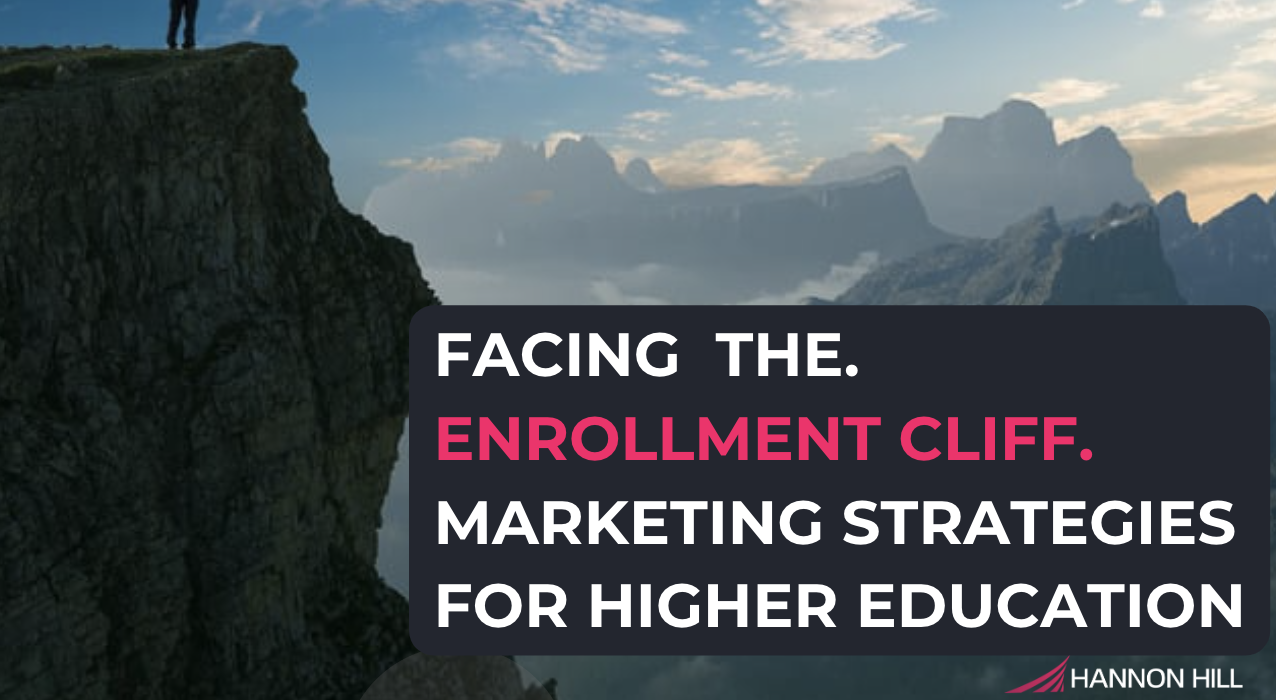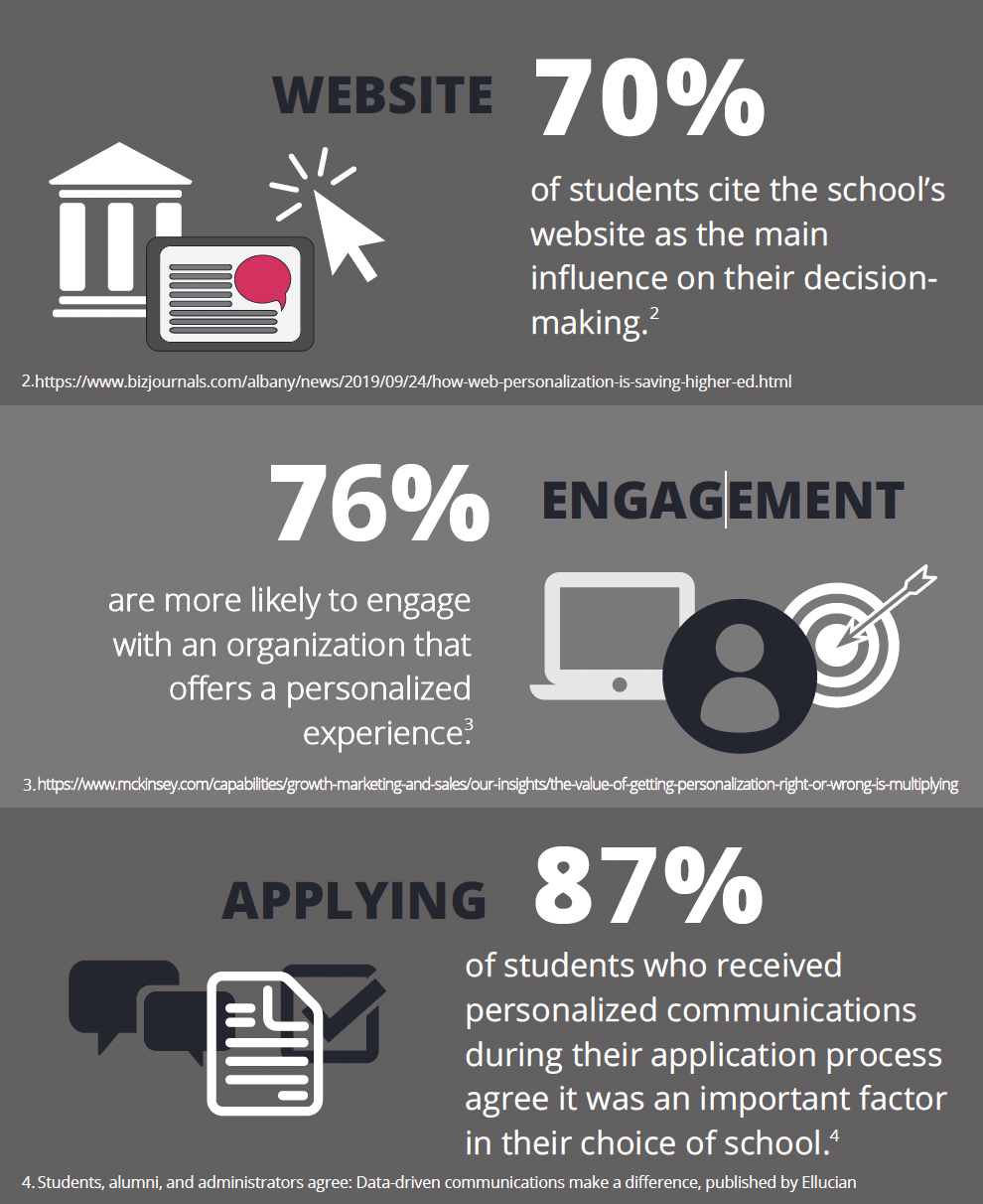
You know this if you are part of the higher education sector and charged with maintaining or increasing student enrollment for your institution.
The “Cliff’s” severity on a given institution depends on several factors, such as demographic trends, geographical location, institutional appeal, and financial stability, to name a few.
Nevertheless, the landscape is shifting, and with it, the need to market an institution.
At Hannon Hill, we are committed to walking alongside our higher education clients and enabling them to communicate their unique value proposition, attract and enroll the right students, retain them, and turn their experiences into legacy.
Cascade CMS, Clive, the Enrollment Cliff Hub, and our Annual User Conference are some ways we help our clients market their institutions and successfully navigate the Cliff.
On February 22, we concluded the 17th Annual Cascade CMS User Conference with a keynote roundtable discussion on the demographic enrollment cliff featuring higher-ed marketing pioneers:
Jaime Hunt, Vice President for University Communications and Chief Marketing Officer at Old Dominion University, and host of the Confessions of a Higher-Ed CMO podcast.
Kristin Nichols, founder of Nichols Higher Education.
Dr. Allison Turcio, Assistant Vice President for Enrollment and Marketing at Siena College and host of The Application Podcast.
Hunt, Nichols, and Turcio offered their unique insights, reflecting on a combined experience of over 60 years in higher education marketing communications and enrollment.
The following recap provides a glimpse into the conversation, and the button below serves as a gateway to watch the entire talk on demand.
The enrollment cliff will cause a number of challenges.
One of the most significant challenges will be the financial strain on regional and small private universities due to a dramatic decline in traditional-aged student enrollment.
“Schools that have not made a significant investment in brand and marketing are sitting in a situation where they are more reliant on tuition than ever before,” says Hunt.
That is a major problem considering the dwindling number of traditional-aged students available.
In fact, the Western Interstate Commission on Higher Education predicts a drop of 350-400,000 traditional college-aged students between 2025 and 2037.
(Source)
The fiscal ramifications for the higher education sector are colossal.
To address the issue, institutions must diversify their offering, look beyond regional lines, and provide flexible learning opportunities such as hybrid or fully online courses to draw students from their competition.
“The schools who have the savviest marketers are going to be the ones who are most successful,” Hunt says.
The phrase "we can't recruit our way out of the enrollment cliff" came up during a webinar on the same topic hosted by Hannon Hill in October 2023 with Dr. Carrie Phillips.
It's no longer feasible to rely solely on recruitment; retention is equally crucial.
One way to do that is by looking at the first-year student journey from the moment they are confirmed to when they are handed off to their sophomore year.
"If we switch our thinking from retention to student experience, that's where we can start to think how marketing can help," Turcio says. "There will never be a replacement for word-of-mouth marketing."
Ask yourself:
That is the norm in 2024.
That is what students are used to when dealing with consumer websites.
There are no exceptions when it comes to higher education.
“We have to influence not just if they stay, but what they say about their experience,” emphasized Turcio.
The demographic shift increases racial and ethnic diversity within the student population.
“U.S. school-aged population, representing ages 5 through 17, are projected to grow more diverse across racial and ethnic identities over the next three decades,” reports K-12 Drive.
Higher education institutions might see more first-generation college students and students from underrepresented groups, altering the support services and recruitment strategies colleges need to employ.
The marketing proverb:
“If you market to everyone, you market to no one,” is widely known and accepted amongst practitioners, regardless of industry.
In higher education, institutions "need to nail down their identity and what is special about them to avoid confusion about their brand when targeting diverse audiences," says Turcio.
Be proactive instead of reactive.
Start identifying your unique value proposition today. Communicate what's in it for the students when considering attending your institution.

Personalized communication is no longer a nice to have but an expectation of website visitors.
According to research, 70% of students cite the school’s website as the main influence on their decision-making.
76% of them are frustrated when they don't receive recommendations that relate to them.
87% of students who received personalized communications during their application process agree it was an important factor in their choice of school.
"We know this is what the consumer wants," says Nichols.
"A one-size-fits-all approach will not help engage students with variant backgrounds and needs."
How do you start?
Nichols recommends compiling a working group of writers, analysts, and photographers to create new pages or microsites for certain demographic groups.
"Start building pages with a handful of top-level populations in mind," Nichols says. "Start small, bullet out the values of each population," and communicate how your institution meets the needs of these target demographic groups in an easily digestible manner.
The old adage, "you have to spend money to make money," does not discriminate against higher education marketing and cares little about the challenges ahead.
The most direct route to securing your marketing budget is "to find a way to tie it to revenue." says Turcio. "So that it doesn't feel like a cost, but a no-brainer investment."
Track your marketing efforts, follow the student journey, and report how your personalization tactics directly impacted student enrollment to help increase the bottom line.
Remember, "you can't cut yourself out of a budget crisis," said Hunt, "especially when it comes to marketing and admissions," recalling a quote by Dr. David Creamer, Vice President for Finance and Business Services & Treasurer at Miami University.
Why?
Because these are the areas that directly affect revenue for an institution!
Therefore, it is vital to show how much money every dollar spent in marketing generates for the institution to make that cost allocation a "no-brainer."
If you're reading this in early 2024, you know artificial intelligence is still a novelty to most.
Embrace it.
Learn it.
Leverage it.
And realize that it is not going away.
AI will not replace you at your job.
The people who master AI will replace you at your job if you refuse to adopt it.
And with AI, especially generative AI tools such as Open AI's ChatGPT and Google Gemini (f/k/a Google Bard), content will be commoditized.
To differentiate your institution in the vastness of content generated by AI, identify what is special about your school and how you can make your students feel special when considering you.
"We have to focus on ‘special’ so that we can stand out," advises Turcio to close out the keynote discussion.
Navigating the challenges of the demographic enrollment cliff requires innovative strategies and a proactive approach in higher education marketing.
Institutions must invest in personalized communication and enhance the student experience to attract, retain, and effectively engage a diverse student body.
Emphasizing the unique value proposition of your institution is crucial in this competitive landscape.
We are grateful to our panelists for their time and invaluable insights in addressing the challenges of the demographic enrollment cliff.
Take advantage of the free insights shared by leading experts in the field.
Click the button below to watch the entire keynote discussion on demand and equip yourself with the knowledge to thrive in the evolving world of higher education marketing.
Last Updated: Mar 5, 2024 11:00 AM